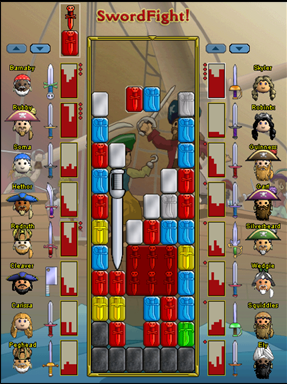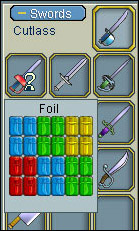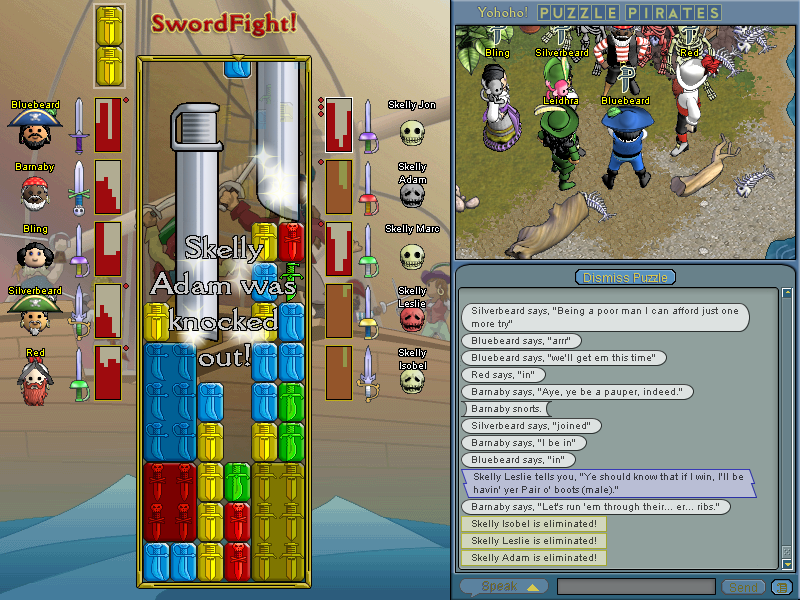Tutorial Contest Entry 8
| This page is an entry in the Tutorial Contest. | |
| Please do not edit this page. Judging is currently in progress, according to the parameters set out in the contest announcement. If you wish to discuss this tutorial or provide feedback, please use the talk page. |
Contents
JUDGES' SCORES
See the forum-announcement post for a description of the judging categories.
The averaged scores of the judges for this entry were:
Clarity: 7.17
Comprehensiveness: 4.83
Contribution: 4.50
Illustrations: 5.83
Presentation: 7.50
Research: 3.17
The final score is a sum of these scores, with "internal" categories (clarity, comprehensiveness, illustrations, presentation) counting 2x as much as "external" categories (contribution, research). Maximum score is 100.
The final score for this tutorial is: 58.33
My Guide to Sword Fighting
1. Introduction
Hello and welcome to my guide on Sword Fighting. Sword Fighting is one of me and my Brother's favourite YPP puzzles. It is a game that any Newbie will thoroughly enjoy, as I did. Even veterans can't take their eyes off it, and can't resist showing off their sword and skill to the new ones.
2. The General interface
1. The Board
2. Types of pieces
There are two different colours, split up into four colours.
Solid Pieces-
These are normal pieces, used to create Blocks (See section 3. for more info). The picture of the sword on the Solid pieces and the colour of the piece determine which Break Pieces are needed to break them. The pictures of swords on them are swords in the game. They come in four colours; Yellow, Blue, Green and Red.
Break pieces-
These are pieces that can break Solid Pieces. These pieces look like swords. Their colour corresponds to the type of Solid piece it can break. It can't break anything otherwise, e.g. you cannot use a Yellow Break Piece to break a Green Solid Piece.
The Break Pieces are the shape of swords found in the game:-
Yellow- Long Sword
Blue- Scimitar
Green- Falchion
Red- Skull Dagger
3. The Player Radar
This is the general Player Radar:
Player Name
This indicates the pirate's name
Player Face
This is what the player looks like
Player Sword
This is the sword that you are using at the moment (you start with a Foil)
Player game board
This shows you and other people (opponents and team mates) what the players board looks like. If you are attacking the player, then this is a good way to see how much damage you are inflicting.
For team mates, you can also see how well your friend is doing.
Amount of opponents attacking player
Dots, located on the left of the mini Game board in the Radar, represent the amount of opponents attacking that player. The colour in the centre of the dot is the colour of your Pommel and the outer ring is the colour of your Guard. If a pirate is being attacked by lots of opponents, then the dots will turn into red dots only, which indicate 5 opponents.
3. Playing the game
1. Attacking your opponent
When you start playing Duels (1 v 1 Sword fights) you may notice Silver blocks fall on the board. These represent your opponent's attacks on you. To send attacks to your opponent, you must use Break Pieces to break Solid pieces. These will fall onto your opponent's board as Silver blocks, more commonly known as sprinkles. Also, as the game progresses, you might hear a sound play twice, followed by a Silver sword. If you want to do the same to your opponent, then create a Block. If you hear three sounds ascending, then this means that either a very big sword or 2+ swords will fall on your board. If you hear a sound completely different to those two, then lots of sprinkles will fall on the board. Blocks are made by putting Solid pieces of the same type together in a 2x2 square or more. This merges into a bigger version of the Solid piece and, when destroyed, will emit stars of the same colour. Swords will destroy any Solid piece of Break piece below it. The bigger the sword, the more it will destroy. Silver swords cannot damage Blocks. When you have made a good block, use a Break Piece to destroy it.
2. Winning and losing
Winning and losing a sword battle changes your standing in sword fighting. If you are really good, you will go up, and if you are bad, then you will go down. The game ends either when one of the players has their pointer covered so they can’t place any more pieces or someone gives up and presses dismiss. Wagering for a game like this is quite fun, because an Able might be able to defeat an Ultimate! The game of sword fighting is hard to master, but when mastered, it becomes as easy as pie!
3. Playing as a team
That was what happens in a Duel. But what about in a Sea battle where there are lots of you fighting lots of them. Well this is the place to look at!
If you are playing as a team of two or more v two or more, then you must bear this in mind;
· The amount of dots next to you indicate how many pirates are attacking you
· The pirate you are attacking has a white border around his/her Radar Game board. (See 2.3)
· How successful your attacks have been on the pirate you are attacking
· How many people left in the opposing team
When you either make a silver sword or destroy single pieces, it will affect only the person that you are attacking and no-one else.
Teaming is also a vital feature in Sword Fighting. Teaming is when more than one pirate work together to eliminate an opponent. To team, you click on an opponent’s face and you will start attacking that opponent.
If the person you are against is eliminated, then a sound will sound and the person’s name will show up on your game board in white, e.g. Fit Bess is eliminated!
If you are eliminated, the same thing will happen.
4. Advanced Swordsmanship
1. Strike patterns
Strike patterns are the key to success in Sword Fighting. It is by far the most important part of the game. Each sword has a different strike pattern, depending on the type of sword it is. To view your strike pattern, mouse over the sword that you want to view the sword pattern of. The pommel and guard determine where the colours fit into the puzzle.
In this example, if a silver 1x4 sword fell onto your board on the left, it would turn blue, blue, red, red, middle, Green, Green, Blue, Blue, and right, Yellow, Yellow, Green, Green.
2. Chain Reactions
Chain Reactions are where destroying one block causes another to be destroyed, and so on. The setting up of them is harder than the execution.
This isn’t a very good example, but if a blue break piece was placed in between the blue next to the Blue block and the blue piece above the Yellow, then they will be destroyed, causing the Green Break piece to fall onto the two Green pieces, resulting in a Double.
5. Challenge
Do you think that you are the best of the rest? Then try these challenges made up by me;
· One minute into the game, try and clear the whole board
· Do you think that you could get a Vegas Chain or more?
· Try and defeat someone that is three standings above you, e.g. Able defeats Master.
Links
http://www.puzzlepirates.com/Swordfighting.xhtml
http://www.puzzlepirates.com/screenshots.xhtml#pillaging-swordfighting_01



